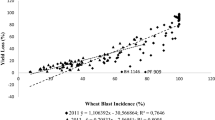Abstract
Bakanae disease is an important fungal disease in the world. No rice (Oryza sativa L.) varieties have been found to be completely resistant to this disease. To facilitate accurate, uniform and simultaneous screening of many rice accessions, we developed an inoculation method for microconidia of Fusarium fujikuroi using a tissue embedding cassette and seedling tray. Standards for evaluating the inoculated rice seedlings as healthy or unhealthy were also established. The method was fast and reproducible for accurately evaluating resistance to bakanae disease in rice.




Similar content being viewed by others
References
Bacon CW, Yates IE, Hinton DM, Meredith F (2001) Biological control of Fusarium moniliforme in maize. Environ Health Perspect 109:325–332
Endo RM, Burkholder EC (1971) The association of Fusarium moniliforme with the crown rot complex of asparagus. Phytopathology 61:891
Iqbal M, Javed N, Sahi ST, Cheema NM (2011) Genetic management of bakanae disease of rice and evaluation of various fungicides against Fusarium moniliforme in vitro. Pak J Phytopathol 23:103–107
Jardine DJ, Leslie JF (1992) Aggressiveness of Gibberella fujikuroi (Fusarium moniliforme) isolates to grain Sorghum under greenhouse conditions. Plant Dis 76:897–900
Khokhar LK, Jaffrey AH (2002) Identification of sources of resistance against bakanae and foot rot disease in rice. Pak J Agric Res 17:176–177
Kommedahl T, Windels CE, Stucker RE (1979) Occurrence of Fusarium species in roots and stalks of symptomless corn plants during the growing season. Phytopathology 69:961–966
Lee YH, Lee MJ, Choi HW, Kim ST, Park JW, Myung IS, Park KS, Lee SW (2011) Development of in vitro seedling screening method for selection of resistant rice against bakanae disease (in Korean with English summary). Res Plant Dis 17:288–294
Ma L, Ji Z, Bao J, Zhu X, Li X, Zhuang J, Yang C, Xia Y (2008) Response of rice genotypes carrying different dwarf genes to Fusarium moniliforme and gibberellic acid. Plant Prod Sci 11:134–138
Mew TW, Gonzales P (2002) A handbook of rice seedborne fungi. Int Rice Res Inst, Los Baños
Michailides TJ, Morgan DP, Subbarao KV (1996) Fig endosepsis: an old disease still a dilemma for California growers. Plant Dis 80:828–841
Nirenberg H (1976) Untersuchungen über die morphologische und biologische differenzierung in der Fusarium-Sektion Liseola. Mitt Biol Bundesanst Land-Forstwirtsch Berlin—Dahlem 169:1–117
Ora N, Faruq AN, Islam MT, Akhtar N, Rahman MM (2011) Detection and identification of seed borne pathogens from some cultivated hybrid rice varieties in Bangladesh. Middle-East J Sci Res 10:482–488
Ou SH (1985) Rice diseases, 2nd edn. Commonwealth Mycol Inst, Kew, pp 262–272
Park WS, Yeh WH, Lee SW, Han SS, Lee JS, Lim CK, Lee YH (2008) Electron microscopic study for the influence of soaking in hot water and prochloraz solution on spore and mycelium of Fusarium fujikuroi infected in rice seed (in Korean with English summary). Res Plant Dis 14:176–181
Park WS, Choi HW, Han SS, Shin DB, Shim HK, Jung ES, Lee SW, Lim CK, Lee YH (2009) Control of bakanae disease of rice by seed soaking into the mixed solution of prochloraz and fludioxnil (in Korean with English summary). Res Plant Dis 15:94–100
Rajagopalan K (1961) Screening of rice varieties for resistance to foot-rot disease. Curr Sci 30:145–147
Saremi H, Ammarellou A, Marefat A, Okhovvat SM (2008) Binam a rice cultivar, resistant for root rot disease on rice caused by Fusarium moniliforme in Northwest. Iran. Int J Bot 4:383–389
Sukapanpotharam S, Chantarasnit A (1980) Genetic evaluation and utilization, disease resistance, a screening method for bakanae resistance. Int Rice Res Newsl 5:6
Sunder S, Satyavir Virk KS (1997) Studies on correlation between bakanae incidence and yield loss in paddy. Indian Phytopathol 50:99–101
Sunder S, Satyavir (1998) Vegetative compatibility, biosynthesis of GA3 and virulence of Fusarium moniliforme isolates from bakanae disease of rice. Plant Pathol 47:767–772
Takahashi N, Kitamura H, Kawarada A, Seta Y, Takai M, Tamura S, Sumiki Y (1955) Biochemical studies on bakanae fungus. Part XXXIV. Isolation of gibberellins and their properties. Bull Agric Chem Soc Japan 19:267–277
Thakur KSS (1974) Role of gibberellic acid, fusaric acid and pectic enzymes in the foot rot disease of rice. Riso 23:191–207
Wulff EG, Sørensen JL, Lübeck M, Nielsen KF, Thrane U, Torp J (2010) Fusarium spp. associated with rice bakanae: ecology, genetic diversity, pathogenicity and toxigenicity. Environ Microbiol 12:649–657
Yabuta T (1935) Biochemistry of the “bakanae” fungus of rice. Agric Hortic 10:17–22
Yang H, Wang ZY, Wu HZ, Zhu CH (2003) Study on the variation of rice bakanae under the different methods of seedling rising. J Anhui Agric Sci 31:119–124
Zainudin NAIM, Razak AA, Salleh B (2008) Bakanae disease of rice in Malaysia and Indonesia: etiology of the causal agent based on morphological, physiological and pathogenicity characteristics. J Plant Prot Res 48:475–485
Acknowledgments
This study was supported by grants from the Rural Development Administration (PJ0086852013).
Author information
Authors and Affiliations
Corresponding author
Additional information
M.-H. Kim, Y.-J. Hur and S. B. Lee contributed equally to this work.
Rights and permissions
About this article
Cite this article
Kim, MH., Hur, YJ., Lee, S.B. et al. Large-scale screening of rice accessions to evaluate resistance to bakanae disease. J Gen Plant Pathol 80, 408–414 (2014). https://doi.org/10.1007/s10327-014-0528-0
Received:
Accepted:
Published:
Issue Date:
DOI: https://doi.org/10.1007/s10327-014-0528-0




